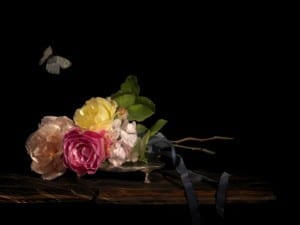Parasol Unit presents a major exhibition of works by two of Sweden’s leading contemporary artists, Cecilia Edefalk and Gunnel Wåhlstrand, on show until 12 February 2012.
Cecilia Edefalk (b.1954) uses traditional methods of oil and tempera in her paintings, which are executed on small canvases. Edefalk often places her work in carefully choreographed arrangements, using mirror effects, displaying paintings at 90-degree angles or turning canvasses upside-down, which lends a quality of performance to her shows.
Gunnel Wåhlstrand (b.1974) uses a meticulous technique, painting with only black ink and water to create photo-realistic drawings on large sheets of paper. Her work is based on photographs found in her family album of her father’s early childhood in Sweden. These images present deeply personal scenes of family life, given a haunting resonance as imposing, monochromatic drawings of an era frozen in time. The precise and demanding work of depicting this archive allows Wåhlstrand to physically and psychologically connect to her father who died when she was one year old.
Aesthetica caught up with Cecila and Gunnel to find out more after the opening earlier this month.
Gunnel Wåhlstrand
A: The family photograph is one of the major motifs in your work. Could you talk us through what this type of photograph means to you?
GW: Before I started painting in this photographic way, I used to paint really fast, often finishing one painting a day where I allowed the ink to spread and chance came into play. I used images, photos of people unknown to me or photos I had staged myself, but this way of working eventually came to an end because it felt too made up to me and I had a sense of circling, avoiding something more essential.
Since my father died when I was only one year old, the photos that remained of him were always very important to me throughout my whole life. At one point, I began every day by flickering through these photos to become focused, and soon realised I needed to find a portal into these pictures, a technique that allowed me to remain in each one of them for as long as possible, since when they were finally finished, I would never return to that certain image or moment.
The black ink is extremely permanent – you can only work from the light quality of the paper towards the darkness of the ink, and never take anything back. Once it’s there it’s permanent – like a slow developing process, which I liked. The level of concentration this technique demanded from me was somehow similar to the concentration within the image, and this similarity made me feel close to them in a very intimate way.
A: This concept of remembrance is a key one in your work. How do you both perform and interrogate the idea of memory, and remembrance in the work on show in this exhibition?
GW: They are not my own memories, but through painting them they somehow become mine. I can’t just paint the mere surface of the photo, I have to go further and understand how everything works and what it looks like from all angles. Only then can I delve into the picture and almost experience the feeling of having been there in that moment. Through recreating the past, that which will be is also added. Therein lies one of the many differences between photography and painting.
A: The family photograph is often discussed as the place for the identification and the formation of identity. Is this something you can relate to?
GW: Yes. They are the origin and the very core of me.
A: What aspect of Edefalk’s work first appealed to you?
GW: The first time I saw her work was at a large exhibition at the Moderna Museet in Stockholm. She was showing grey paintings, some of which are part of the show at Parasol unit. They stayed with me and helped me take the leap into grey myself.
A: And now you know her work better?
GW: I have been following her work since that first time, but some of the older paintings included in the show were new to me. It’s nice to see all the stages she has gone through over the years, and how the spiritual, ethereal quality has always been there. One of the striking things about her work is how the ever present inner bright light almost obliterates itself and makes the air vibrant.
Cecilia Edefalk
A: The relational nature of your work requires the physical installation of your paintings to become an integral part of your practice. Could you talk us through how you have installed the work in the current show at Parasol Unit?
CE: The space itself is the starting point for the installation and also the distance between the works. First I was very confused as the different works I am showing are picked from my entire career as an artist and Ziba Ardalan (Director/Curator at Parasol) helped me with the outlines of the installation. She knows the physical space and I know the space in my works. It was very excitng to put the exhibition together, linking the paintings and sculptures together and thereby creating a new and old story that exists physically during the time the exhibition is up but that also exist as a memory for those who had the opportunity to see the exhibition.
A: What aspect of Wahlstrand’s work first appealed to you?
CE: The vibrating stillness.
A: And now you know her work better?
CE: The way she is investigating and creating darkness , shadows and light.
Time and Memory: Cecilia Edefalk and Gunnel Wåhlstrand, 23/11/2011 – 12/02/2012, Parasol Unit, 14 Wharf Road, London. www.parasol-unit.org
Aesthetica Magazine
We hope you enjoy reading the Aesthetica Blog, if you want to explore more of the best in contemporary art and culture you should read us in print too. You can buy it today by calling +44(0)1904 479 168. Even better, subscribe to Aesthetica and save 20%. Go on, enjoy!
Caption:
Gunnel Wåhlstrand, By the Window, 2003–2004.
Ink-wash on paper, 151 x 198 cm, The Michael Storåkers Collection.
Photograph Björn Larsson





